Wind tunnel tested: 18 road bike wheelsets go head to head
Princeton, Enve, Scope, Syncros, Cadex, Roval and more. We took the market's best aero road wheels to the wind tunnel to find out which were fastest

When it comes to upgrades for your bike, there are few as exciting as a new set of wheels. They can make a bike faster, lighter, better handling, more enjoyable to ride, and let's face it, deep aero wheels just look cool.
But if you're looking to upgrade, how do you choose the right pair of wheels for your bike?
Of course, there are compatibility concerns that you'll need to overcome to ensure the wheels you choose will actually fit your bike, but beyond those, as in all walks of life, the answer is: "it depends."
Your main motivation for a new set of wheels will probably be because you want to go faster, but there are several factors that combine to make one wheelset better or worse than another, and the importance of those factors will depend on the type of terrain you'll be riding on.
When riding uphill, it's a fair assumption that a lighter wheelset will make you faster, but for everywhere else – downhill, on the flat, and even on slight uphill gradients – a more aerodynamic wheelset will benefit you more.
For this reason, brands are often keen to point out the aerodynamic credentials of their new release. It's rare to see a new wheelset launched without some sort of claim that it can save you X watts against the old model, or Y seconds over an arbitrary time trial distance.
Those claims are nice to have, but although some brands are becoming more transparent about their testing methods, we still need to take each claim with a grain of salt. After all, marketing departments won't want to tell you if their product is slower, will they?
That's where we come in! Over the past year, we've been taking the best products in various categories into a wind tunnel ourselves, testing them head to head with each other to see which are fastest.
We've wind-tunnel tested road wheels before, but as part of our growing series of lab-based tests, we wanted to revisit that with a more thorough and up-to-date test with more wheels, more testing speeds, and a bit of additional data alongside.
So last week, we took 18 wheelsets to the Silverstone Sports Engineering Hub, the world-renowned testing facility used by manufacturers, professionals and WorldTour teams alike. We also weighed and measured each wheelset to provide a more complete picture of which are the best on the market right now.
Before we get into the data, a quick interlude to say this article includes paid product placement from Schwalbe and Reap Bikes. I personally approved their inclusion, having agreed they would offer no unfair bias, nor the appearance of bias, to any of the wheels on test. Neither of which had any input into the test protocol or the results.
We paid the same rate that any member of the public would pay for the use of the wind tunnel and borrowed everything used in this test. Without our subscribers, these tests cannot happen, and so a fair and impartial protocol is essential to their success and the ability to continue doing them.

The wheels
We took a lot of wheelsets - somewhere in the region of 25 - plus a baseline shallow wheelset to compare against, and although we ran out of time to test everything we took, we successfully got through 18 tests, which are listed below.
Our aim was to have a selection of mid-depth wheelsets across a broad price spectrum, covering those that everyday cyclists may be looking to buy as well as premium wheelsets that are more in the when-I-win-the-lottery category. We also wanted to reflect wheels found in the WorldTour peloton.
We opted for the highest-spec wheelset from each brand where available. Some were unable to get us the very top-spec model, such as Campagnolo, which sent the Bora WTO rather than the slightly more premium Bora Ultra WTO.
It's worth adding that most brands offer a more budget-friendly alternative to the wheelsets we've tested here.
In alphabetical order, the wheels we tested are as follows:
- Black Inc 48/58
- Black Inc 62
- Cadex 50 Ultra
- Campagnolo Bora WTO 60
- Enve SES 4.5
- Enve SES 6.7
- Hunt Sub 50 Limitless
- Parcours Strade
- Princeton Carbonworks Wake 6560 Evolution
- Reserve 52/63
- Roval Rapide CL II
- Scope Artech 6.A
- Scribe Core SuperLight 60
- Shimano Dura Ace C50
- Swiss Side Hadron Ultimate 500
- Syncros Capital SL Aero
- Vision Metron 60 SL
- Zipp 404 Firecrest
- Plus our baseline: Fulcrum Racing 5
Similar to using the Trek Emonda ALR as a baseline in our wind tunnel superbike test, we wanted an entry-level product in the test for a couple of reasons.
Firstly, we wanted not only to show the difference between Fancy Wheelset 1 and Fancy Wheelset 2, but how those wheelsets differed from a low-cost option.
Secondly, we think the Fulcrum Racing 5 is a common example of a modern budget wheelset, and if you're reading this with a view to upgrading, there's a good chance you have a similar set on your own bike. Therefore, it offers a good idea of how much you're likely to gain when upgrading.
We also aim to take the Fulcrum Racing 5 back to the tunnel in future tests to provide a constant comparison.
As for the test wheelsets, we were limited to a point by what we could get our hands on. We rely on brands' goodwill to lend them to us, and most brands believe in their product enough, and trust our impartiality enough, to agree.
However, sometimes, things don't work out. For example, we requested wheels from Fulcrum, Corima, Winspace, Lightweight and others, but our requests either went unanswered, or logistical difficulties (aka slow couriers and overzealous customs controls) stopped play.
We also took along some Zipp 808 Firecrest wheels to see how much extra could be gained by switching to even deeper wheels, but unfortunately ran out of time before we could test them. Next time!
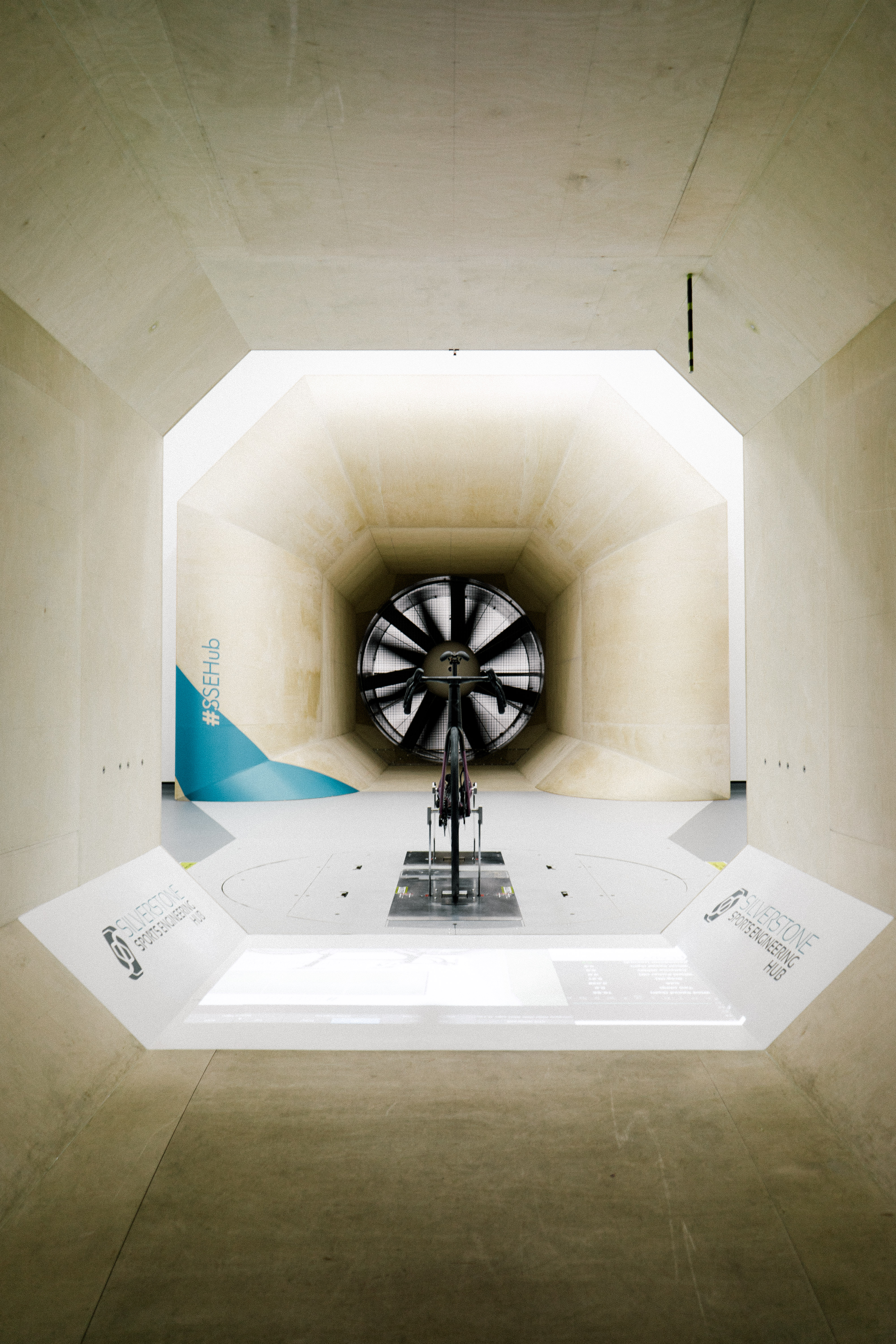
The test
As with previous tests, we took the wheelsets to the wind tunnel at the Silverstone Sports Engineering Hub, and we tested the aerodynamic performance of each wheelset.
This is measured in Coefficient of Drag x Area (CdA), and is quantified in metres squared. To briefly explain the two parts, the Coefficient of Drag defines how easily air passes over an item's surface, and is influenced by its shape as well as the material on its surface. Area is quite simply a measure of the item's size; the bigger something is, the more wind it hits as it moves through the air, and the less aerodynamic it is (all else being equal).
Ultimately our primary aim was to find out which are the fastest, and what sort of savings you can expect to make by upgrading from a nominally average wheelset to a go-faster carbon fibre aero wheelset.
From that, we can also derive whether upgrading your wheels is a good value-for-money decision when compared to other available upgrades. Coupled with our wind tunnel helmet test, our wind tunnel superbike test, our rolling resistance tyre test, and all of the upcoming lab tests we've got in planning, we want to help our readers decide where to spend their money first in order to get faster… well, faster!
Sign up to the Musette - our subscriber-only newsletter
Each data capture was performed in five-degree increments from -15 to +15 degrees of yaw, the angle at which the wind hits the bike. That means seven capture points at -15, -10, -5, 0, +5, +10 and +15 degrees. Each capture was performed in a sweep in the same direction (negative to positive) for consistency.
We performed this sweep for each wheelset at three speeds: 30kph, 40kph and 50kph. We know that some wheelsets perform better than others at lower speeds, while others sail, using the wind to create lift and provide forward propulsion, as speeds increase. The sooner this happens, the better a wheel is likely to be for everyday riders. To capture data at one speed and extrapolate from there would miss this crucial difference and offer inaccurate results. For an example of this, keep an eye out for the results of the Princeton wheels below, and how their positions in the rankings improve at higher speeds.
This means a total of 21 CdA measurements per wheelset, or 399 measurements in total when including our baseline wheelset.
We then used this data to calculate the watts required to propel the bike at the three given speeds, using the formula below. This is for comparative purposes alone, we know bikes cannot pedal themselves!
Power (watts) = 0.5 x AirDensity x CdA x Velocity^3

Protocol & standardisations
The test was standardised, meaning the same conditions were met for each wheelset during each data capture. These included the bike, the wind speed, the tyres, disc rotors, cassettes and more.
Prior to each test, the wind tunnel underwent a taring process, similar in principle to the tare on your kitchen scales or zero-offsetting your power meter to ensure accurate readings.
Each wheelset was mounted to the same bike: a Reap Vekta in size 56cm. Our stipulation here was to use a bike that had no affinity to any of the wheel brands in question, and Reap was a good match with aerodynamics at its forefront. A Specialized Tarmac, for example, would have been designed in conjunction with the Roval wheels and could, in turn, create an unfair advantage to those wheels. Likewise, a Giant Propel could unfairly benefit the Cadex wheels, Cervélo with Reserve, and so on.
We tested using the bike alone, without a rider present, but with the wheels spinning at the appropriate speed. When we previously tested wheels in 2022, we first did some preliminary tests where we tested multiple wheelsets with a rider, and then again without a rider. The differences between each wheelset were the same in both tests, but to capture the data with the rider present, we needed longer captures and it introduced more variability due to the potential movement of the rider. Having found the same results with improved statistical confidence in less time, it was a no-brainer to continue without a rider, and so we took the same approach this time round too.
Each wheelset was fitted with a 28mm Schwalbe Pro One TLE tyre. Some of the wheels on the test were designed around a 25mm tyre, so we will note those below where relevant.
For cleanliness and ease, we used inner tubes, and we used tubes with a valve of the shortest functional length. We wanted to mimic what riders will actually use in the real world, rather than potentially skew the data for shallower wheels with ungainly 80mm valves in the name of standardisation.
Each wheelset was fitted with identical Shimano Dura-Ace disc rotors and a Shimano 105 cassette.
Tyres were inflated to between 50 and 60psi, guided by the SRAM tyre pressure calculator based on internal rim widths and whether they were hooked or hookless.
Each wheel was checked before going into the tunnel to ensure the tyres were inflated and seated correctly. Wheels were then mounted into the test bike by a Silverstone Sports Engineering Hub engineer to ensure consistency.
Holding the bike in place was a set of stanchions. No corrections were made for these since they were the same across all tests. We're interested in the difference between wheels here, not the absolute values.
Confidence
Our confidence margin for our results is +/- 0.0009 CdA, or 0.32 watts at 30kph, 0.76 watts at 40kph, or 1.49 watts at 50kph.
This was calculated with a baseline test at the start of the day and an end-of-day repeat with the same setup after the tyres, cassette and rotors had been removed and refitted.

Other data we captured
We know that aerodynamics is only one part of the puzzle that combines to create a wheelset's overall performance, so throughout the day, we also captured some additional data. We didn't capture internal width because our calipers couldn't measure hooked rims accurately, so we'll use quoted internal widths where relevant.
- Weight
- External width
- Depth
- Measured width of a 28mm tyre
- Hooked or hookless
- And finally, price!
Additional details and disclaimers
Cyclingnews does not claim that this data is the final word on the aerodynamic performance of the wheels featured, but rather an additional stream of independent, unbiased testing and information for our readers.
The results are simply representative of our day of testing. We hope that being clear about our method and our protocol allows readers to appreciate the data while also understanding the bigger picture.
We understand that manufacturers may achieve different results with different protocols, and that some wheels in this test were designed around different tyre models, different tyre widths, and sometimes in conjunction with a specific bike. Where we have information to this end, we will include it.
For simplicity, we will report individual CdA data as it comes out of the wind tunnel software, but where relevant, the graphs used show our error margin.
When averaging the CdA data, we have weighted yaw angles according to the 2018 research paper by Cannondale's Nathan Barry. This calculates the likelihood of experiencing each yaw angle at given speeds in the real world and applies an appropriate weighting to each CdA measurement. In layman's terms, as you travel faster, you're more likely to experience low yaw (wind head-on) than high yaw (crosswind), simply by virtue of the speed of your movement through the air.
Weighting the yaw angles appropriately when averaging the CdA provides a more accurate real-world interpretation of which wheelset will actually make you faster.
Using these averages, we've then calculated to solve for power (watts) at the tested speeds. These calculations use a constant air density of 1.2kg/m³, and do not factor in additional losses such as drivetrain friction or rolling resistance.
Cyclingnews also understands that there is more to a wheelset's performance than aerodynamics. Weight, handling and stability are key for ride quality, while serviceability, tyre compatibility and retention, and how easy they are to get the tyres on and off are also important. This context should not be ignored when viewing the results below.

Present on the day
- Me - Josh Croxton: Overseeing the test, helping with wheelset preparation, ensuring tyres were seated and pressured correctly prior to testing, helping with wheelset swaps
- Tom Wieckowski: In charge of wheelset preparation and additional data capture
- Will Jones: Chief photography officer, responsible for all the excellent photography you see here, and helping with wheelset preparation
- Sam Gupta: Chief videography officer, responsible for social media video creation and helping with wheelset preparation
- Ben Meir (Reap Bikes): Provider of the test bike, assisted Silverstone's engineers with wheelset swaps
- The team from Silverstone Sports Engineering Hub: Running the wind tunnel to ensure reliable results, and in charge of swapping wheels to ensure fair protocols

Results
And with all that done, let's get into the fun stuff, the results!
Given we have the CdA of the bike alone, rather than a bike with a rider on it, the calculated wattage numbers are small. To explain: An approximate CdA for a road cyclist is around 0.3, whereas the CdA values here are between 0.09 and 0.1, and the approximate wattage to ride at 40km/h here works out at between 65 and 80 watts. This is unrealistic, but it is still valid for comparing one against another. Some of the graphs below will quote this data, but I've also calculated the watts saved vs the baseline wheelset.
Most of this section will be graphs and tables, but below, we'll dive into each wheelset to provide individual findings.
Hold onto your hats!
Starting with some raw data, the above graph shows the CdA for each wheelset at each yaw angle, tested at 30kph. Notice how some wheels get faster at higher yaw angles as they use the wind to sail.
Next up, the same CdA data for each wheelset at each yaw angle, but when tested at 40kph.
Here, most wheels are within a close range at zero yaw, but while the Black Inc 48/58 gets progressively slower as the wind comes from the side, the rest tend to sail at 10 degrees or more. The Syncros wheels are fastest at 5 and 10 degrees, but the Scope wheels are super fast at 15 degrees.
Next up, the same data again, but tested at 50kph.
Once again, those Syncros wheels are rapid at 5 to 10 degrees, but the Scope wheels are marginally quicker at 0 yaw, and faster than anyone at 15.
Interestingly, the Roval Rapide CL II performed worst at this speed at lower yaw, but at 15, they sailed nicely.
So far we've teased out a few things, but with so many intersecting lines, it's difficult to pull out any real trends, so next up, I have averaged the CdA results and worked out the watts required to pedal at the three given speeds (30, 40 and 50kph).
Analysing these three charts, you can see that across all speeds, the Scope Artech 6.A and the Syncros Capital SL Aero did very well. The Enve 6.7 wasn't far behind, and the Vision Metron 60 SL was up there too. Also a shout out to the budget-friendly Scribe Core SuperLight 60, which at £999 for a pair, punched well above its price point.
There's a bit of a trend to highlight here too, in that the deeper wheels unsurprisingly fared better than the shallower wheels. There were some outliers though, such as the ~60mm deep Princeton Carbonworks Wake 6560 Evo and the Campagnolo Bora WTO 60, which both landed mid-table results, and the Enve SES 4.5 which beat them both.
Black Inc may be disheartened to see its 48/58 wheelset performed poorly but will be buoyed by the fact that its newer aero wheelset, the Sixty Two, was in the top half consistently, aided in the big picture by their comparatively low weight too.
Of course, don't forget there's an error margin to account for, which can shuffle most wheelsets up or down a few places, and bear in mind that the three X-Axes here start above zero, so the results appear more pronounced.
Watts saved vs baseline
I think this is the clearest graph of them all. It shows the watts saved against our baseline wheelset for each of the three speeds.
I have ordered by 40kph.
Note how the Princeton wheels work better at the higher speed, and the Reserve wheels perform better at the lower speed.
From our data, we can conclude with confidence that at pro peloton speeds of 50kph, the Scope Artech 6.A wheels are at least 3.42 watts faster than the Roval Rapide CL II.
At more amateur racing speeds of 40kph, we can conclude that you stand to save at least 8.99 watts when upgrading from an entry-level wheelset to the fastest.
We can also say that at a more everyday speed of 30kph, the budget-friendly Scribe Core 60 wheels will save you at the very least 3.51 watts, or 1 minute 43 seconds over a 40km time trial riding at 250 watts.
Error margins work both ways though, so taking it the other way, if we calculate the maximum possible saving (according to our statistical error) between the baseline Fulcrum wheels and the Syncros Capital SL Aero at 50kph, you stand to save a significant 20.63 watts.
I know not too many people will be upgrading from a baseline to a wheelset as premium as those Syncros wheels though, so a more realistic upgrade to the Scribe Core 60 can save you as much as 18.63 watts.
At 30kph, a speed most of us will be able to ride, you stand to save as many as 5.63 watts switching between the baseline wheels and the Scopes.
Aero vs weight
The accepted rule with wheels is that generally, the deeper they are, the more aerodynamic they are, but with extra material comes extra weight, so the trade off usually goes something like "do I want to prioritise aero for flatland speed, or save weight and be faster when climbing?"
While this is still a fair generalisation, our test found the opposite correlation.
The Scope Artech 6.A wheels, which were the fastest at 30 and 40kph, were also the lightest on our test at 1280g. The Syncros Capital SL 50 - fastest at 50kph - were the second lightest at 1311g!
Now, there's another big part to this equation which you may have already figured out, and that is price.
Aero vs price
Across the 18 wheelsets, our test found a slight correlation between price and performance - no surprises there - but it's not completely clear-cut.
The two fastest wheelsets are the two lightest wheelsets, but they also happen to be the most expensive on test. This suggests the more you pay, the better performance you can expect to get, but according to our results, you're not guaranteed speed if you spend more, and you can definitely get speed without spending heaps.

Individual results
Now it's time to dig into each wheelset's performance at an individual level. Here I will list all of the data we captured, alongside a graph of the CdA vs yaw for each of the three speeds.
I will also add some context around each wheel where I have it, such as if the wheel was designed around a specific tyre width, in conjunction with a particular bike, or developed by the brand using different testing protocols.
What's more, each of the brands in the test has been given an opportunity to analyse the data and provide a comment prior to publishing. Not every brand has chosen to, and that's fine. Others have been extremely transparent and forthcoming in explaining their designs and motivations. Where a comment has been received, it will be included.
Fulcrum Racing 5



Fulcrum Racing 5
Specifications
Average CdA: 0.1008
Watts saved: 0.1008
Average CdA: 0.0942
Watts saved: 0.00
Average CdA: 0.0899
Watts saved: 0.00
Starting with our baseline wheelset, the 24mm deep, alloy-rim Fulcrum Racing 5 DB. These are a fairly everyday entry-level model.
They'll never compete with the deeper-section aero wheels, but given they're priced at a third of the price of the cheapest set here, and around a tenth of the price of the most expensive, that's hardly a surprise.
To our mind, they're a pretty good representation of the wheels you're likely to get on your entry- to mid-level budget road bike, so will hopefully give you a feel for how many watts you can save when upgrading your own bike.
They do feature a reasonably modern 'U' shaped leading edge, but their 24mm depth does little to use the wind to its advantage. At 20mm internal, they're the narrowest on test, but you'll find wheels as narrow as 17mm if you shop at this pricepoint. They weighed in on our scales at a little over 1.7kg, which again, is the heaviest on test.
Black Inc 48/58

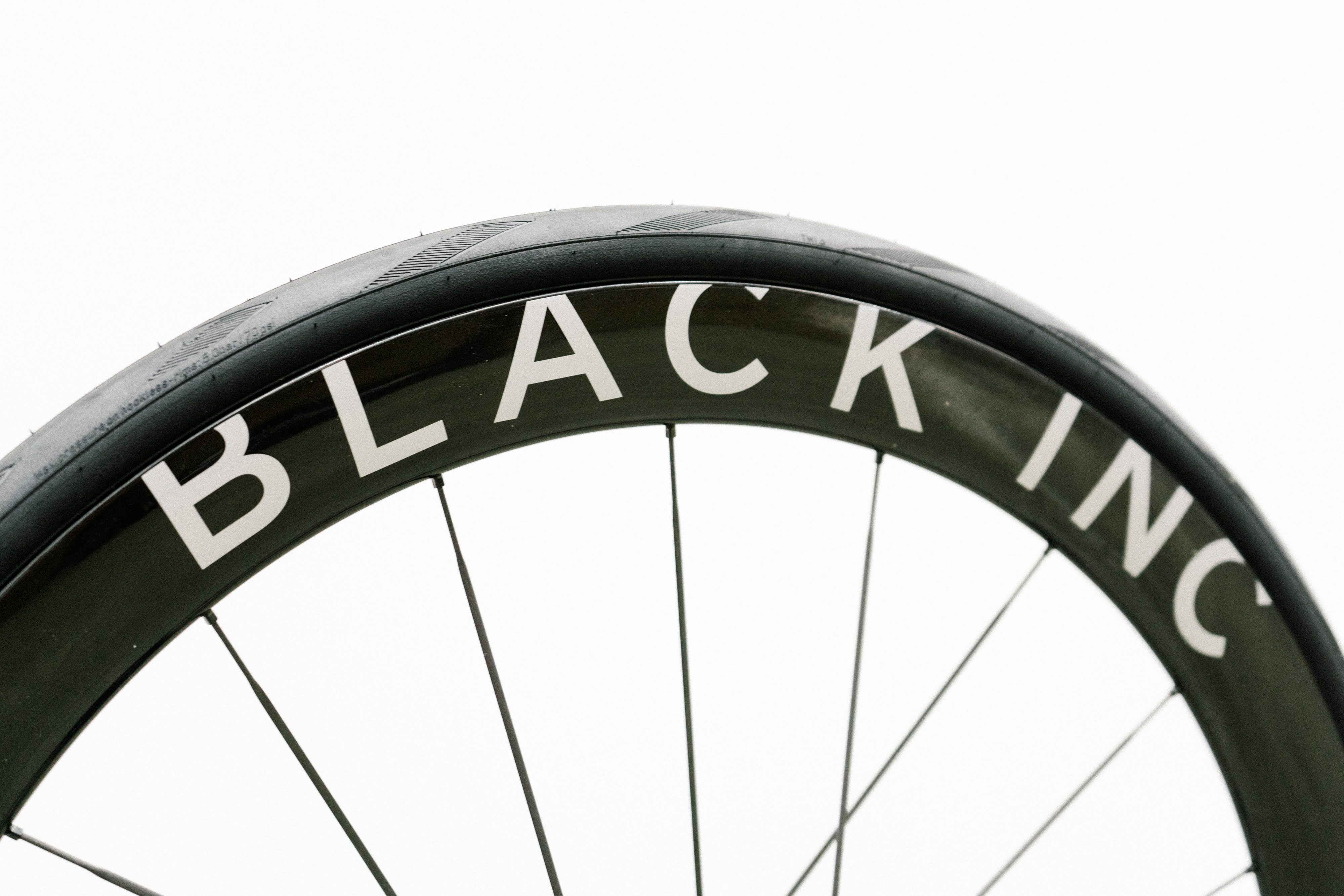

Black Inc 48/58
Specifications
Average CdA: 0.0919
Watts saved: 3.09
Average CdA: 0.0860
Watts saved: 6.81
Average CdA: 0.0827
Watts saved: 11.47
The Black Inc 48/58 is the first of two Black Inc wheels we tested here. They are specced on the Factor Ostro VAM which came out very well in our recent road bike wind tunnel test. The fact that they've come out among the slowest here shows just how aerodynamic that frame must be. The deeper Black Inc Sixty Two wheels, detailed below, are newer and deeper, and Factor should be buoyed by the fact that they're faster.
The 48/58 wheels are, as the name suggests, 48mm deep at the front and 58mm deep at the rear. They are pretty lightweight at 1366 grams, thanks in part to the carbon spokes and the lightweight hub, but they're not quite market-leading for a wheelset of this depth.
They feature a 23mm internal bead with a 'mini-bead hook' that is genuinely minuscule, and the 28mm Schwalbe tyre blew up to a little over 29mm by our calipers.
Notably, in the graph above, you can see how they struggled to sail at the higher yaws at 30 and 40kph, actually getting slower at higher yaws until you get to 50kph. In the real world, this would likely mean you need to work harder in windier conditions at those speeds.
Shimano Dura Ace C50



Shimano Dura Ace C50
Specifications
Average CdA: 0.0919
Watts saved: 3.09
Average CdA: 0.0857
Watts saved: 7.00
Average CdA: 0.0821
Watts saved: 12.53
With their 50mm depth, 28mm external width and 21mm internal width, the Shimano Dura-Ace C50 is the wheelset of choice for many WorldTour teams. They are the wheelset that Mathieu Van der Poel used to win the 2024 Paris Roubaix, for example, so they have some pretty serious victories under their belt, despite not landing such a great result in this test.
On our scales, they came in at 1492g, which isn't portly but is certainly beaten by other 50mm options here. Perhaps surprisingly, our tyres measured up slightly wider at the rear than at the front, despite no obvious difference between the two rim shapes.
Roval Rapide CL II



Roval Rapide CL II
Specifications
Average CdA: 0.0906
Watts saved: 3.53
Average CdA: 0.0854
Watts saved: 7.31
Average CdA: 0.0828
Watts saved: 11.28
The Roval Rapide CL II wheels are a rung below the more premium CLX II wheels, offering similar performance but at a more budget-friendly price. So subtle are their differences that we actually believed we had the CLX II, and so were initially surprised by their result.
They bear the same rim shape as the CLX II, and so have the same stark difference between the two rims. The front is 51mm deep, while the rear is 60mm, and then despite both front and rear having a 21mm internal width, the front is a massive 35mm wide up front, and the rear is comparatively narrow at 30.7mm.
As we understand it, the wheels were originally designed around the Specialized Turbo Cotton tyre. The brand promises "the same aerodynamic performance across various tyre sizes," and recommends 28 or 30mm. They were also designed in conjunction with the Specialized Tarmac, whereas we've tested with a Reap Vekta bike here.
However, the CL II forego the bladed aero spokes and use DT350 hubs instead of Roval's own with DT Ratchet EXP internals.
As promised, we allowed each brand to comment on our results, and on the belief that we'd tested the CLX II wheels, Specialized said the following:
“We appreciate Cyclingnews' commitment to unbiased data-based reporting. Unfortunately, these results don't align with previous third-party testing, our own internal testing, [and] other brands' testing. The results are not accurate to what we know is true for our product and many of the others in this test. We'd be very hesitant for any rider to make a real-world decision based on the outcome of this test. We've offered to have an open dialogue with Cyclingnews to learn from them and to share our learnings from thousands of days of testing in multiple tunnels around the world."
Specialized isn't the first brand to offer an open dialogue in relation to our lab tests, and as I've done with all others so far, I will happily accept and try to learn ways we can improve these tests for our readers.
Zipp 404 Firecrest



Zipp 404 Firecrest
Specifications
Average CdA: 0.0904
Watts saved: 3.61
Average CdA: 0.0845
Watts saved: 7.98
Average CdA: 0.0814
Watts saved: 13.61
The Zipp 404 Firecrest wheels are hookless, with a 23mm internal rim width and a 58mm depth.
They're not the top-end wheels in Zipp's all-rounder 404 range, that accolade goes to the 454 NSW with their sawtooth profile. Unfortunately, SRAM couldn't get those wheels to us in time.
The 404 Firecrests might not get that sawtooth profile, but they do get a dimpled surface across the face of the rim, which Zipp says helps manage airflow around the rim and contributes to a faster, more stable wheel. We haven't tested stability here, but having ridden them, I have no reason to argue this claim.
In our test, they might have landed in the bottom half, but they're among a cluster of wheels with a similar result, so with our confidence margin taken into account, they can lay claim to as high as 6th place.
"This protocol looks solid," complemented Zipp's Category Manager, David Morse.
He explained that by testing the wheels in a bike, we had captured "the interactions between the wheel, the bike, and the components, which can be a significant factor," adding that our decision to test without a rider is "good for repeatability but leaves off some critical context."
"For the purposes of this test, it’s probably the right choice to leave the rider off as the test aims to show really small differences."
"Aero wheel design has converged over the past five to ten years and the differences are becoming even more marginal."
Interestingly, and reassuringly, having only seen the raw data, Morse requested that our wattage figures highlight the error margin and that we use a weighted average yaw result. Both of these I had already implemented before his 11th-hour comment landed in my inbox.
He also gave some insight into Zipp's testing methods, which may help our future wheel tests: "At Zipp, we typically test wide yaws first and work back to 0 from each side. We have seen this drives more consistent results because it forces a stall condition at the beginning of the test run."
More specific to the 404 wheels, he drew reference to Zipp's 'Total System Efficiency' which is another reminder that we shouldn't forget the bigger picture when considering these results:
"We made a tradeoff between aerodynamics and CRR due to the wider tyre bed, which is 23mm internal. A 28mm labelled tyre will measure wider on the 404 Firecrest than most other wheels tested, which will impact the aero performance in a slightly negative way, but also impact the rolling resistance positively.
"Given the tight margins between many of the wheels, this could lead to significant changes in the rankings across wheel models. We would expect the 404 Firecrest to jump up in the rankings after considering the CRR benefits of a wider tyre bed, even if it’s a 1 to 2W CRR benefit at 30kph. This deliberate strategy comes from Zipp’s Total System Efficiency (TSE) design philosophy."
Swiss Side Hadron Ultimate 500


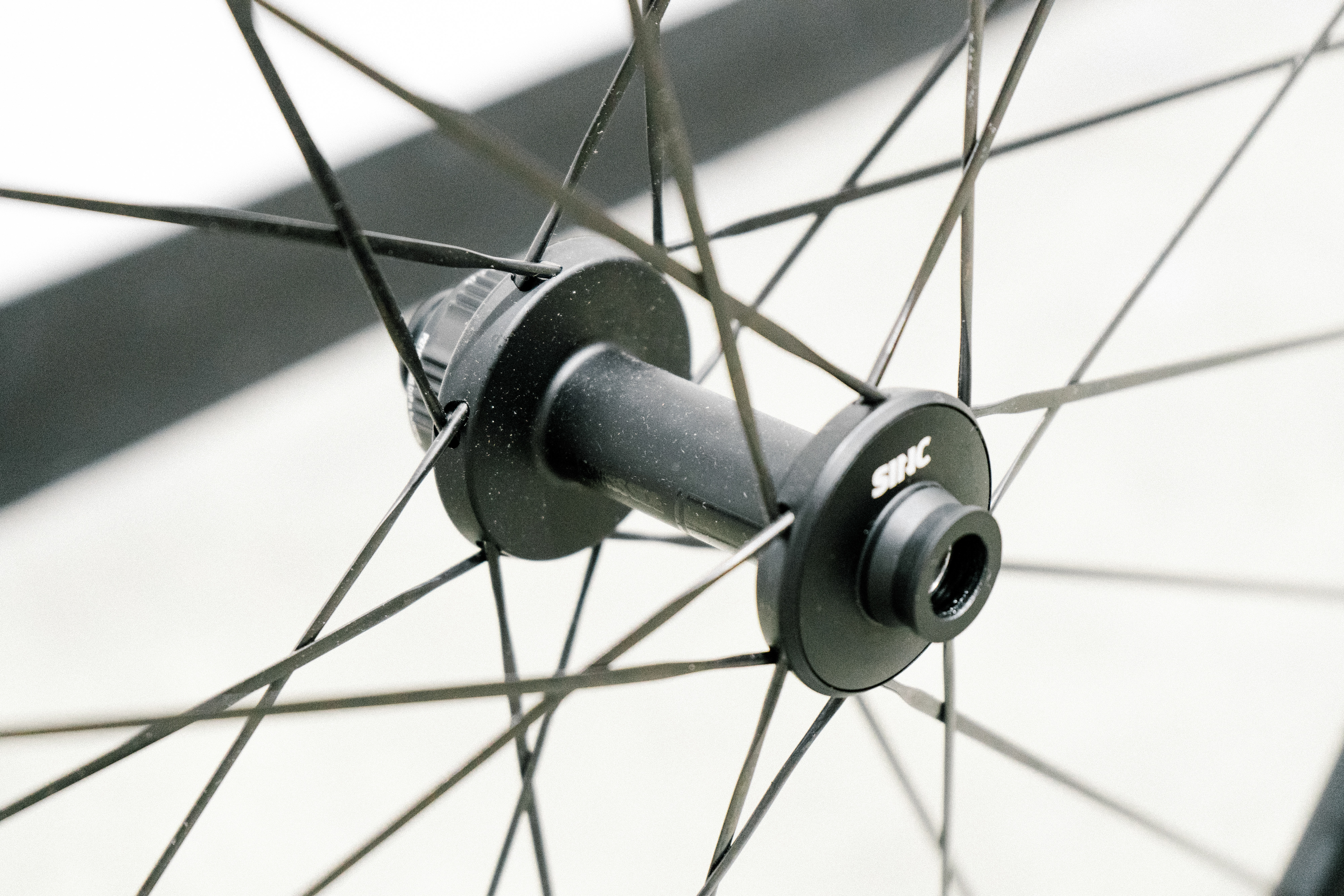
Swiss Side Hadron Ultimate 500
Specifications
Average CdA: 0.0903
Watts saved: 3.66
Average CdA: 0.0845
Watts saved: 8.04
Average CdA: 0.0813
Watts saved: 13.82
There's no doubting Swiss Side's aero credentials, and although the brand makes the Hadron2 Ultimate in a 62mm depth, the only ones we could get our hands on here were the 50mm deep version. They come with a relatively narrow internal rim width of 20mm, a quoted external width of 27mm (though 26.5 on our verniers). Despite this, they ballooned our tyres out to around 29mm.
At 50mm, they were some of the shallower options in this test, but fared reasonably well regardless, sitting among a cluster of similar performers at all speeds. Swiss Side says they are designed around 25 and 28mm tyres. The stainless steel spokes are bladed, and they come with hidden nipples as well as a flange that covers the spokes at the hub, which perhaps contributed to the overall performance.
Princeton Carbonworks Wake 6560 Evolution
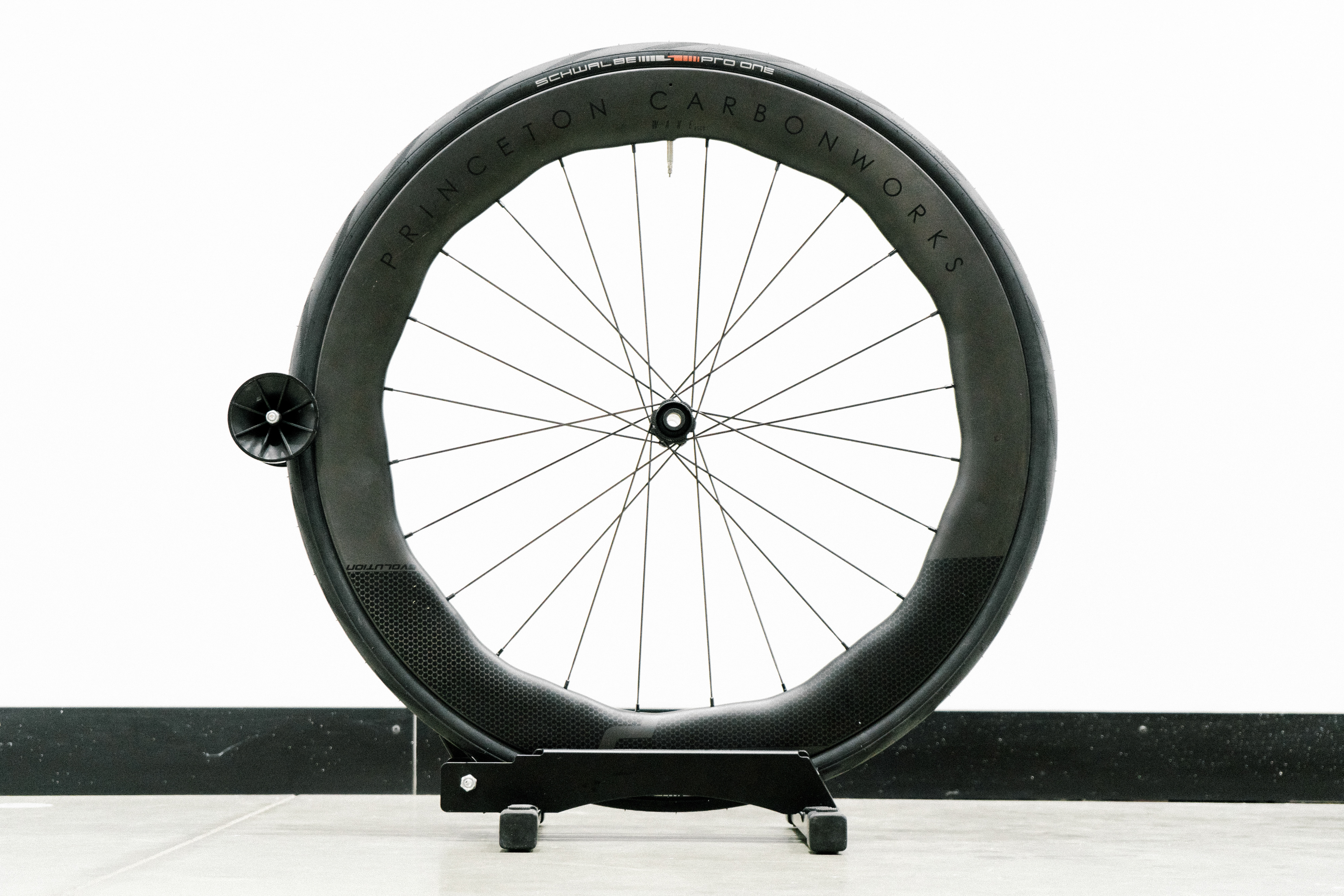


Princeton Carbonworks Wake 6560 Evolution
Specifications
Average CdA: 0.0911
Watts saved: 3.35
Average CdA: 0.0840
Watts saved: 8.40
Average CdA: 0.0806
Watts saved: 14.93
The Princeton Carbonworks wheels are a highly revered premium wheel brand. So much so that the Ineos Grenadiers were happy to break out of an existing sponsorship agreement to use them.
According to the brand's CEO, Harrison Macris, the brand's goal with these wheels was "to provide the best wheel for our pro peloton riders and the tyre they specify, and will only change or update our wheels when we know exactly what tyres they will be on."
They feature an unusual wave profile. According to the brand's website, this is said to "allow the steeper, high-tension spokes (drive side rear spokes and disc side front spokes) to connect to a deeper rim section, thereby flattening those spoke angles."
This, the brand says, helps to balance spoke tensions, creating a stiffer, more uniform wheel.
They are 1,453g for a pair on our scales, and given they don't need rim tape, will help to save a bit of weight there too. They have a 21mm internal width, and blew our tyres out to 29.5 and 29mm respectively.
Perhaps most important of all though, is that the Princeton Carbonworks Wake 6560 Evo wheels are available in a rim brake guise - a rarity these days.
Cadex 50 Ultra

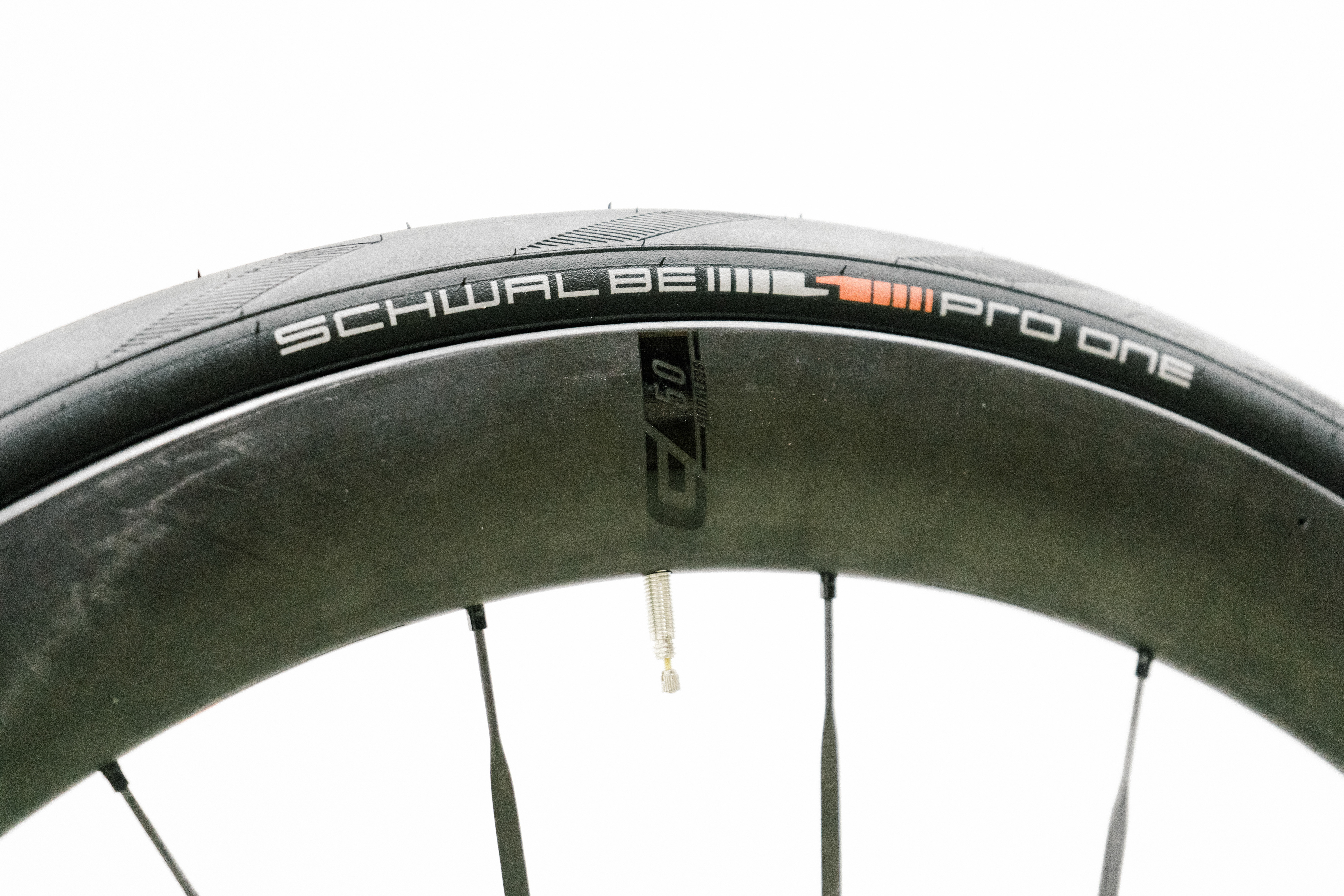
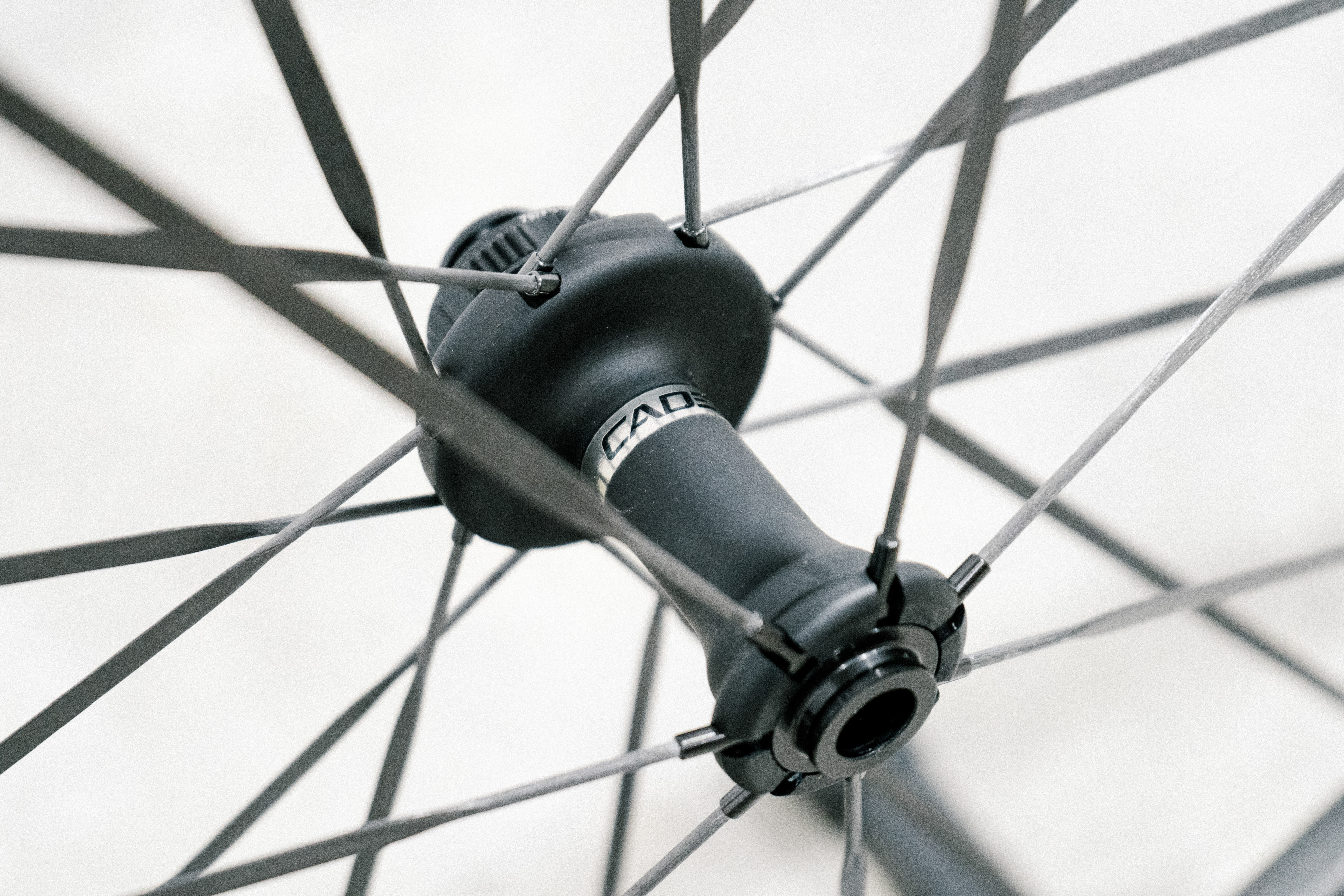
Cadex 50 Ultra
Specifications
Average CdA: 0.0903
Watts saved: 3.64
Average CdA: 0.0841
Watts saved: 8.31
Average CdA: 0.0810
Watts saved: 14.21
The Cadex 50 Ultra wheels are, as the name suggests, 50mm deep. Their party trick is the ultra-deep carbon-bladed spokes. They lace Cadex's own RC-3 Aero hubs, with their ceramic bearings, into rims that boast a 22.4mm internal width and hookless beads. Our 28mm tyres were inflated out to a consistent 29mm front and rear.
The wheels tipped the scales at 1413g, which although not the lightest, were only beaten by more expensive models.
According to Giant, in its own competitor benchmark testing, the Cadex 50 Ultra wheels outperformed some of the models that have beaten it here, and its engineers believe that is due to their test using a pedalling dummy, as opposed to the bike-only protocol we've used. Having delved into the brand's whitepaper, it's evident the brand's own protocol went deeper than ours, as we'd expect.
It included a test with Cadex's own Aero tyre; a second test with the Race, the GP5000 25, the S-Works Turbo 26, and a Vittoria Corsa 25c; a third test with those tyres when mounted into a Giant Propel Advanced SL, and then a fourth test with the Cadex Aero tyres when mounted on the Propel, a Specialized Tarmac SL7, a Canyon Aeroad CFR, and a Cervélo S5. In the on-bike tests, a pedalling dummy was used.
Despite the differences, Giant's representative was happy with the results of our test, given it was up against some deeper competitors.
Campagnolo Bora WTO 60

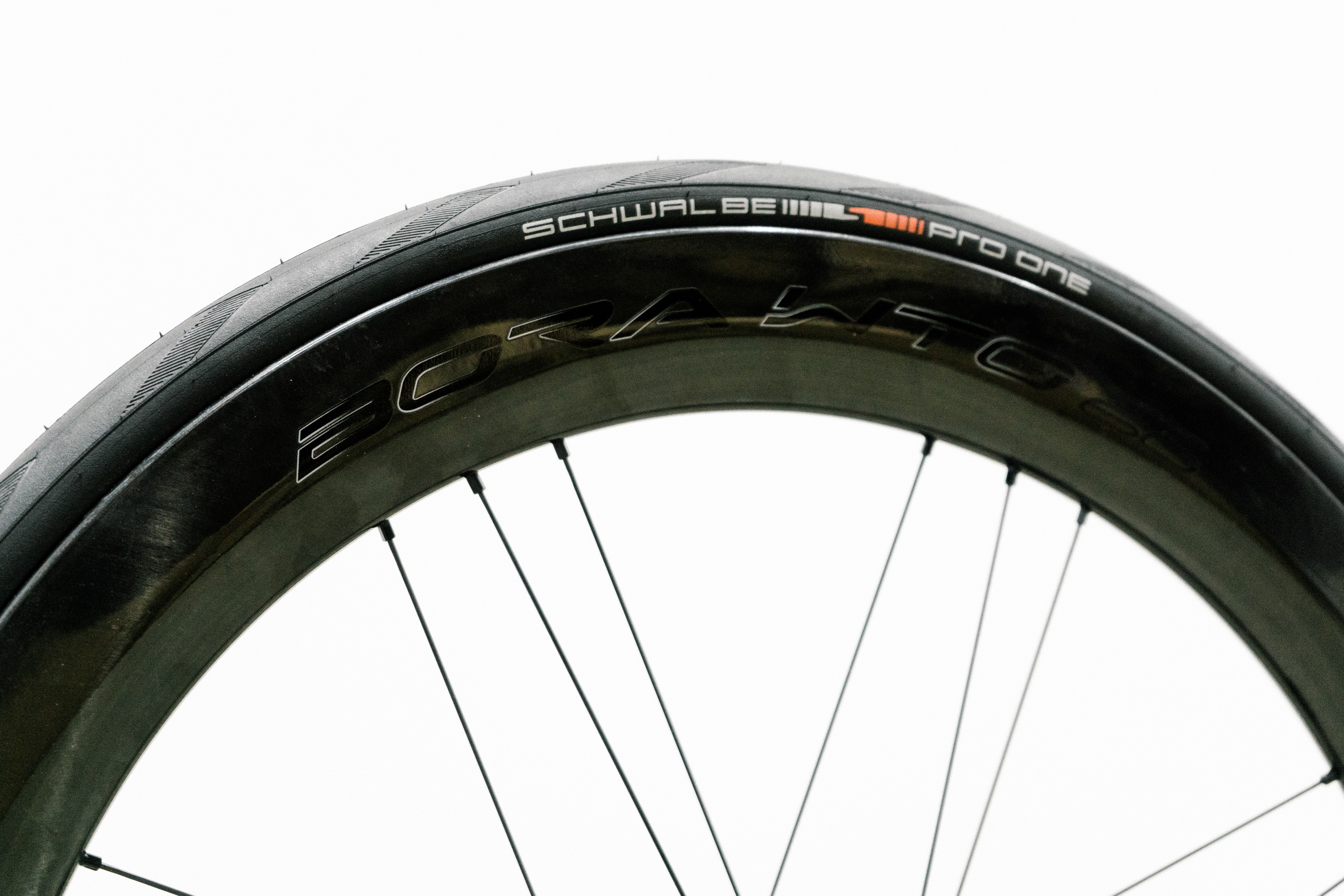

Campagnolo Bora WTO 60
Specifications
Average CdA: 0.0897
Watts saved: 3.85
Average CdA: 0.0840
Watts saved: 8.45
Average CdA: 0.0811
Watts saved: 14.04
The Bora WTO 60 aren't Campagnolo's top-tier wheel in the Bora range. That accolade goes to the Bora Ultra WTO, which boasts fewer spokes, hidden nipples, ceramic bearings, weight loss, and a few other tricks. Unfortunately, we couldn't get those in time, but these held their own very well.
Despite their 60mm depth, they were mid-table on the weight scales at 1491g, beating a handful of shallower models. Will - my esteemed colleague - thinks these are the best-looking of the bunch. The G3 spoke pattern, which groups spokes into threes and doubles the drive-side spoke count, certainly adds an aesthetic point of difference, and Campagnolo says it helps to counteract the asymmetric drivetrain and disc braking forces.
They have hooked beads, split by a 23mm rim bed, and our 28mm tyres blew out to 30mm front and rear.
You can see in the graph above that they stalled a bit at 30kph, getting slower rather than faster at 10 and 15 degrees, but as the speed grew, their performance did too.
Black Inc 62



Black Inc 62
Specifications
Average CdA: 0.0897
Watts saved: 3.85
Average CdA: 0.0839
Watts saved: 8.47
Average CdA: 0.0809
Watts saved: 14.35
Black Inc is a subsidiary of Factor Bikes, a growing brand out of Taiwan owned by Miami-born Rob Gitelis, who built his career owning factories and building bikes for brands he now calls competitors, such as Cervélo. His factory is now exclusively used on Factor's bikes and Black Inc's components, as he explained in our in-depth interview earlier this year.
The Black Inc 62 are the brand's deepest road wheels (excluding discs and trispokes), and landed a solid 6th place on the scales at 1425g. They boast an internal width of 23mm, with a 'mini hook' bead. They're recommended with a 28mm tyre, and blew our Schwalbe Pro Ones out to 30.2mm both front and rear. They're made with carbon fibre spokes and Black Inc's own lightweight hubs.
To my mind, they are some of the best-looking of this bunch, though the big white logos might put some people off.
Like the Campagnolo wheels above, they stalled somewhat at 30kph, getting slower at higher yaw angles, but they came into their own at higher speeds. In an ideal world, we'd test each wheel at a greater number of yaw angles and more speeds to find out the point at which the wheel begins to sail, but that's not massively important for a broader comparative test such as this.
Hunt Sub 50 Limitless UD Carbon Spoke


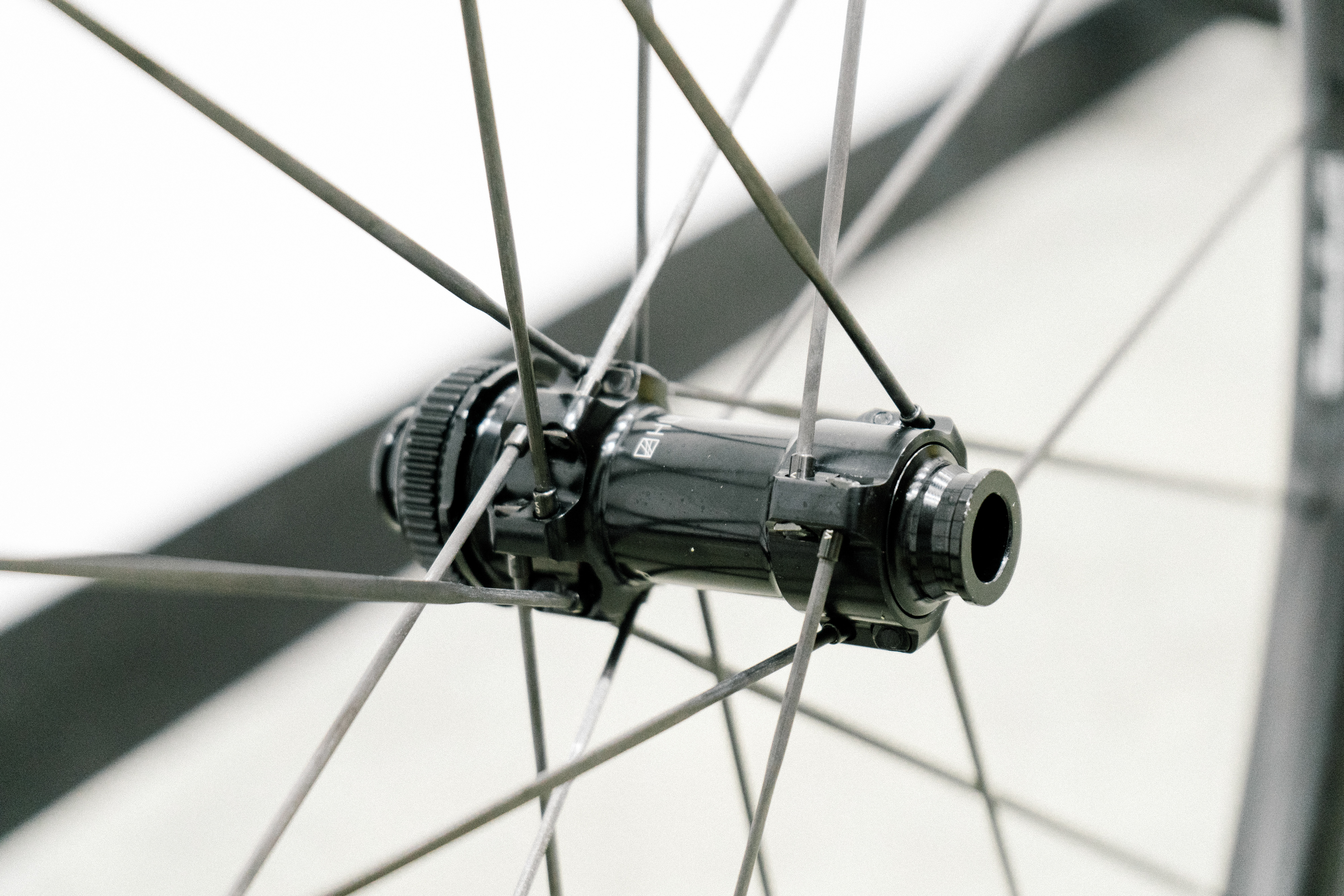
Hunt Sub 50 Limitless UD Carbon Spoke
Specifications
Average CdA: 0.0889
Watts saved: 4.13
Average CdA: 0.0841
Watts saved: 8.36
Average CdA: 0.0812
Watts saved: 13.85
The Sub 50 Limitless comes in two guises, with stainless steel spokes or with lighter-weight UD carbon spokes. Our test here includes the latter, priced at £1,849.
Hunt's transparency in its testing when launching these is to be applauded. It shows both the Roval Rapide CLX II and the Enve SES 4.5 as being faster but leans on the low weight of the Sub 50 and positions it as a good balance of weight and aero. In our Hunt Sub 50 review, our reviewer Josh Ross was very impressed, giving them 4.5 out of 5 stars.
Hunt also offers a lifetime 'H_Care' crash replacement warranty on this wheelset, free of charge. So if you're the original owner and you write them off in a crash, you'll get a replacement set at no cost. It's not the only brand to offer such a thing, but among all this talk of watts and grams saved, this is a tangible benefit, bringing peace of mind to most of us for whom a new aero wheelset is a real investment.
Notably, unlike the Campag and Black Inc 62 wheels above, the Hunts did well at all speeds, catching the wind at higher yaw to reduce drag even at lower speeds.
Given the Sub 50 are among the shallower on test, Hunt's owner, Tom Marchment, was happy with their performance:
“We are very pleased with these results showing us in the top three across all speeds for aerodynamic gain per mm depth - outperforming all other wheelsets of a similar depth. This shows that our advanced aerodynamic shapes are effective in creating gains across the speed range without having to accept the compromises traditionally associated with very deep-section wheels."
Marchment then went on to explain Hunt's own protocols:
"We test further, to the broader yaw angles of the Mavic WAD. The benefits shown here on the Sub 50 Limitless and, for example, the Roval Rapide CLX II continue into wider crosswinds than measured in this test providing lower drag, more stability and greater predictability than more traditional, narrower V shapes.”
Parcours Strade
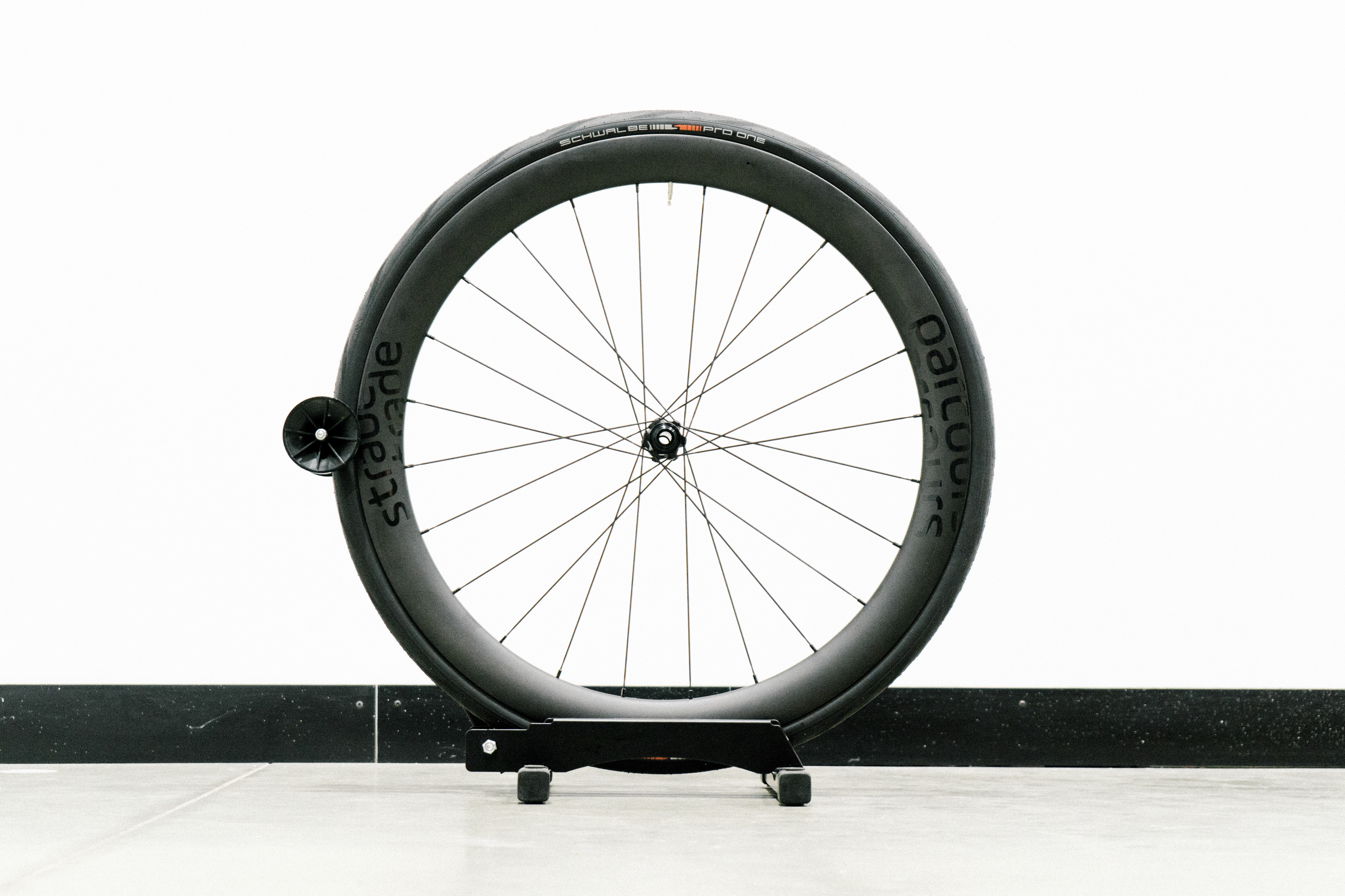


Parcours Strade
Specifications
Average CdA: 0.0889
Watts saved: 4.12
Average CdA: 0.0840
Watts saved: 8.39
Average CdA: 0.0812
Watts saved: 13.94
Parcours is a British brand with a reputation for offering good wheelsets at a good price. The model tested here were priced at just £1,099.00, though you can upgrade to ceramic bearings for a £300 uplift. In addition to the relatively low price point, the Strade also comes in as one of the shallower options in our test, so punches above its weight quite well.
When you take the error margin into account, these wheels can lay claim to 4th place at 30 and 40kph, and 3rd - a podium finish - at 50kph. Impressive stuff.
Parcours founder, Dov Tate, is an Oxford-educated engineer with a history in aerospace, and is building something of a reputation for pushing the boundary of cycling aero testing and understanding. His research into yaw angle weighting and time trial tyre aero testing are two such examples. Of all the brands we contacted, Tate was most keen to understand our testing methodology and subsequent calculations.
He offered a specific comment, which I've pasted in verbatim below:
"We’re thrilled to see how well the Strade wheelset performed in such a comprehensive test and it was fantastic to see the results when up against some deeper competition. Furthermore, we were also pleased to understand how the results in our most commonly-recorded real-world wind conditions really make the wheels stand out against some top-class competition.”
Reserve 52/63



Reserve 52/63
Specifications
Average CdA: 0.0883
Watts saved: 4.33
Average CdA: 0.0840
Watts saved: 8.39
Average CdA: 0.0814
Watts saved: 13.64
When we tested wheels in 2022, Reserve was still a relatively unknown brand. It sponsored the women's Jumbo Visma team, but the men's team were still racing on Shimano. Its 50/65 wheels came last in our test - not by much, but last nonetheless - and the response I received from my contact at PON Holdings - the parent company behind Reserve, Cervélo, Santa Cruz and others - was something along the lines of "we'll improve."
And boy have they. Since that test, Reserve has doubled its sponsorship to the men's team - now known as Visma-Lease A Bike - and its wheels have come on leaps and bounds, offering wider profiles, shaping tyres well (wider than any other here) and winning all three of the men's grand tours in the 2023 season.
At 30kph, they tested 5th fastest, and with our error margin taken into account, can lay claim to a win. With that said, though, at higher speeds they fell down the pecking order slightly.
Enve SES 4.5
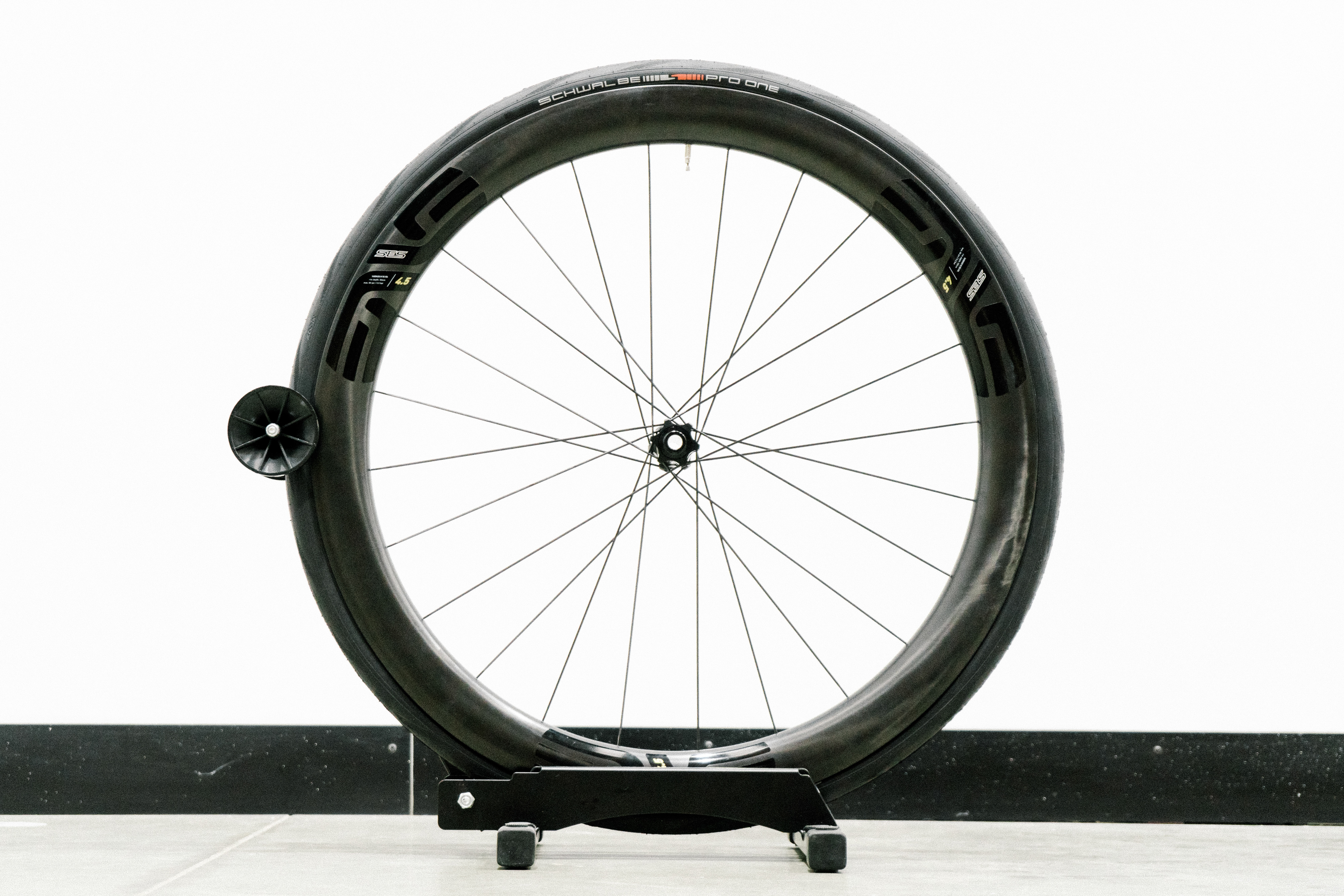
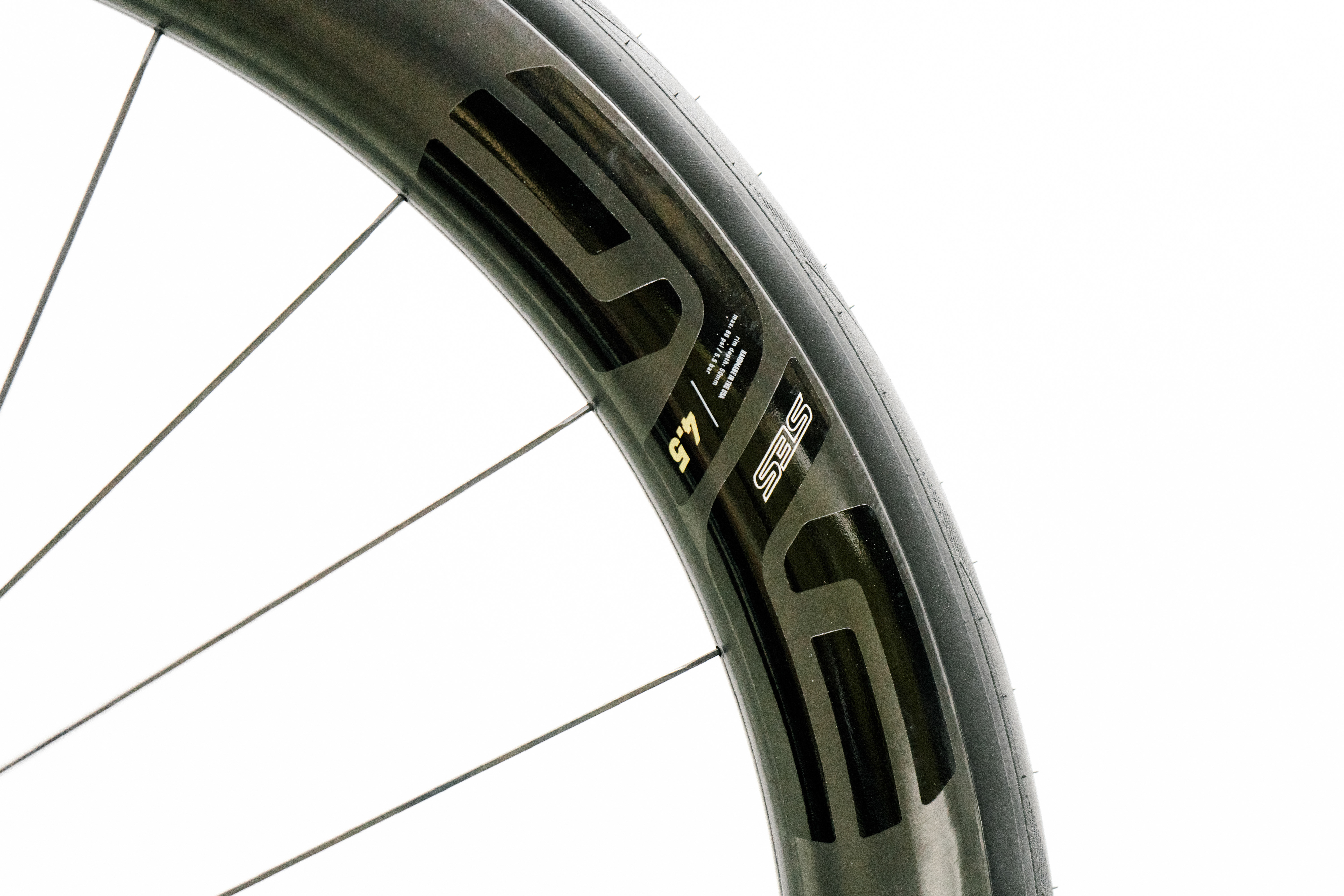

Enve SES 4.5
Specifications
Average CdA: 0.0886
Watts saved: 4.24
Average CdA: 0.0834
Watts saved: 8.89
Average CdA: 0.0808
Watts saved: 14.53
Despite their name, the depth of the Enve SES 4.5 isn't 45mm, but 50mm at the front and 56mm at the rear. That puts them just on the shallower end of our test. They are also the wheels with the widest internal width on our test, at 25mm, with an external of 32.55mm at the widest point. They ballooned our 28mm Schwalbe Pro One tyre out to 30.1mm.
Enve says they're aero-optimised for tyres between 27 and 28mm wide (as labelled). The brand makes its own tyres, so presumably there would be a slight aero benefit to using those, but as mentioned a few times already, we wanted to standardise to avoid offering any wheel an unfair advantage.
Interestingly, maybe due to that wider width, the SES 4.5 weighed slightly more on our scales than the deeper Enve SES 6.7, albeit at a difference of just 11 grams.
Scribe Core SuperLight 60



Scribe Core SuperLight 60
Specifications
Average CdA: 0.0888
Watts saved: 4.16
Average CdA: 0.0831
Watts saved: 9.15
Average CdA: 0.0801
Watts saved: 15.66
Perhaps the best value success story of this test comes from the Belfast, Northern Ireland-based Scribe, with its sub-£1000 Core SuperLight 60 wheelset.
The brand says its goal is "to offer customers the best-specced wheels possible; for the money and the level of technology."
Weighing in at 1442 grams, they're not the absolute lightest on this test, but compared to the other 60mm wheels, they're pretty good. They're beaten by the hyper-pricey Scope and Syncros options, but they're 50g lighter than both the Campagnolo Bora WTO and Enve SES 6.7 wheels, and an impressive 185g less than Vision's Metron 60 SL.
At all speeds, they can lay claim to a podium finish once our error margin is accounted for, and can even claim top spot at 40 or 50kph. This is in spite of a relatively narrow (by today's standards) 21mm internal width, which contributed to tyre widths of 28.7 and 28.9mm front and rear respectively.
They are another brand to offer a lifetime crash replacement scheme, as well as a three-year warranty. On top of this, you can trade them in via the brand's Re Gen scheme.
Understandably, the brand was happy with the results.
"We've been developing the SL range to push the boundaries of aerodynamics (and rolling resistance) for a long time, and it's great to go head-to-head with the biggest players out there. We also hand-build all of our wheels at our operations in N. Ireland to make sure we have full control of QC."
Vision Metron 60 SL

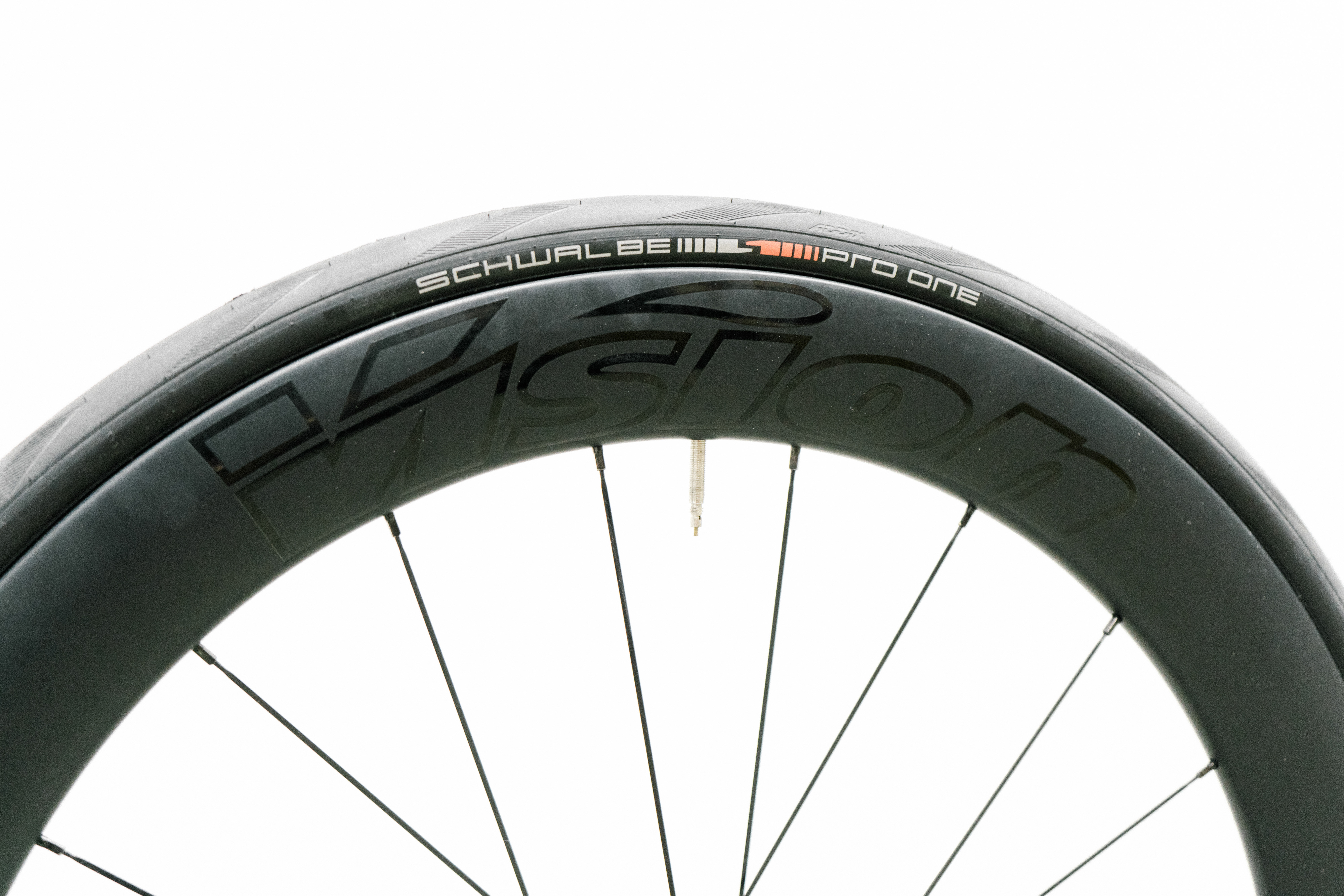

Vision Metron 60 SL
Specifications
Average CdA: 0.0870
Watts saved: 4.79
Average CdA: 0.0827
Watts saved: 9.46
Average CdA: 0.0802
Watts saved: 15.45
Another with quite a high WorldTour presence, the Vision Metron 60 SL is, by the brand's own admission, an older design now, and when offered a comment, simply stated they were "more than satisfied considering the average cost of the other wheelsets."
That old design includes a relatively narrow (by today's standards) 21mm internal width, and a 28.9mm external by our verniers. They are designed around a 28mm tyre, with a hooked bead, stainless steel aero-bladed spokes and steel bearings (rather than the occasionally-specced ceramic)
In our test, they weighed in at 1628g without valves or tape, but with the Shimano freehub. This was a bit of a surprise given when we weighed them for our last test, they were 1460g, and they were 1580g with valves and tape when we reviewed them. We've since weighed them again on a different scale with the same result, so we're confident this number is accurate for the wheelset tested on the day.
Regardless, the number you can trust is the CdA value, which like our Metron 60 SL review concluded, shows a decent performance, including a 2nd place at 30kph, 4th place at 40kph and 5th place at 50kph. Once the error margin is accounted for, Vision can technically claim victory across the board, saving you as many as 11 watts at 40kph against our baseline wheels.
ENVE SES 6.7



ENVE SES 6.7
Specifications
Average CdA: 0.0874
Watts saved: 4.64
Average CdA: 0.0821
Watts saved: 9.98
Average CdA: 0.0794
Watts saved: 16.79
Into the top three, when ranked by average CdA across all speeds, we have the Enve SES 6.7, which will save you an impressive 16.79 watts against the baseline at pro racing speeds of 50kph. They are the wheels that Tadej Pogačar used throughout his dominant 2024 season and were in fact chosen by UAE Team Emirates staff off the back of a LOT of comparative aero testing by the team. I for one would love to see that data.
They feature a modern shape, with an internal width of 23mm and an external of 30.4 up front, and 29.4 at the rear by our measurement. That blew the tyres out to 29.5mm in both cases and created a smooth transition from tyre to rim. They did a good job of sailing at higher yaw, but offered a decent aero performance across all yaw angles at all speeds, making them an apparent good all-rounder.
They are slightly let down by their weight, though. Given their £3300 price, you'd be forgiven for expecting more (well, less) here.
Syncros Capital SL Aero



Syncros Capital SL Aero
Specifications
Average CdA: 0.0870
Watts saved: 4.77
Average CdA: 0.0818
Watts saved: 10.27
Average CdA: 0.0789
Watts saved: 19.15
The Syncros Capital SL Aero are the most expensive wheels on this test, at a pretty wild £4,200, but what's even wilder is their design, which comprises a one-piece carbon construction that includes 16 carbon spokes per wheel. It also boasts a hookless rim bead and 23mm internal width that, in our test, blew the tyres out to 29 and 30mm respectively.
Syncros says the carbon spokes are 35% stronger than steel spokes, while adding torsional stiffness too.
Impressively, despite their 60mm depth, they tipped the scales at 1311g and given they don't need rim tape to work tubeless, they save a few grams there too.
Notably, they are designed around Schwalbe's 28mm Pro One Aero tyre, which while similar to the Pro One TLE we used, features notable differences including varying profiles front and rear, and claims a 20% drag reduction compared to the Pro One TT.
Scope Artech 6.A

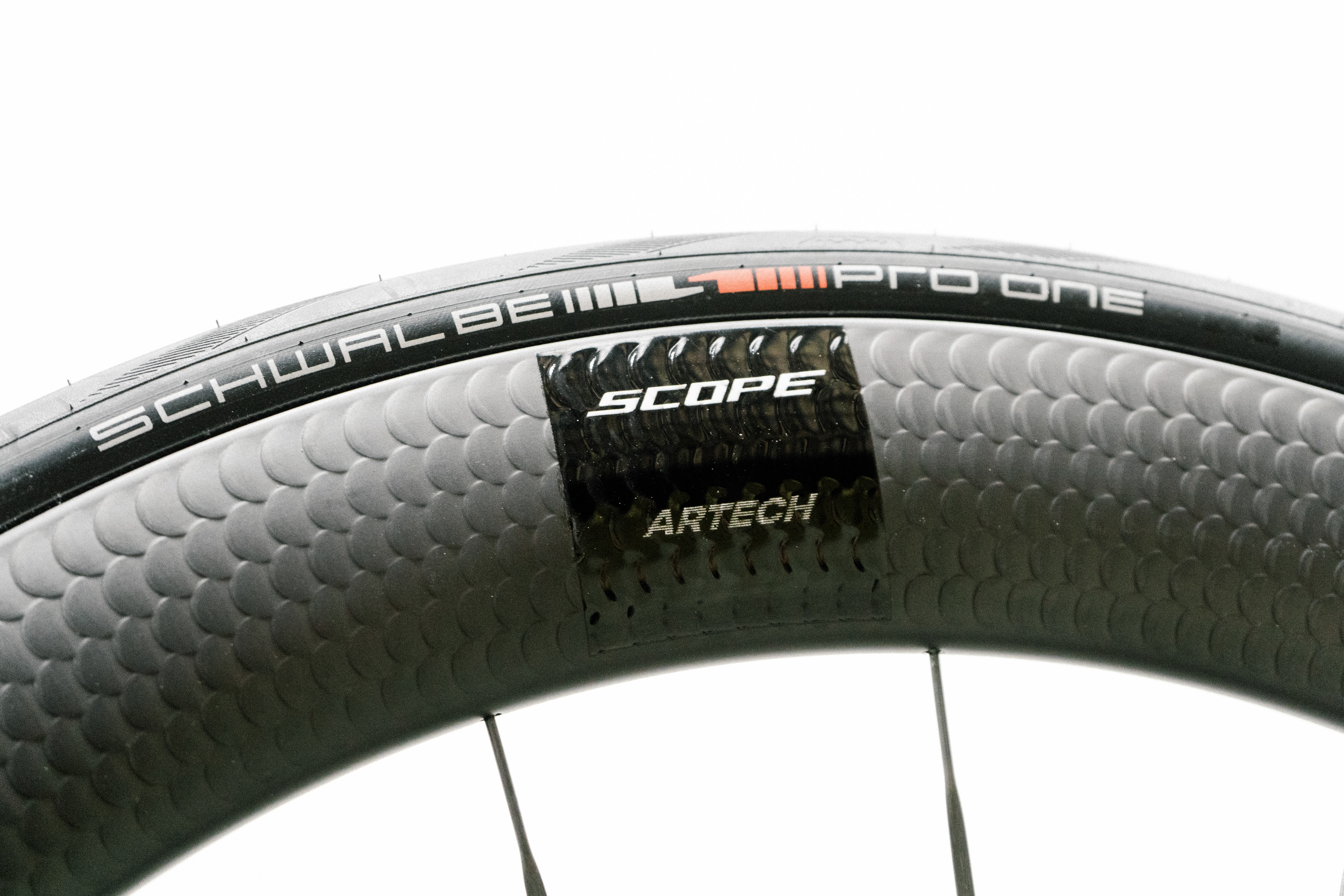

Scope Artech 6.A
Specifications
Average CdA: 0.0864
Watts saved: 4.99
Average CdA: 0.0815
Watts saved: 10.51
Average CdA: 0.0790
Watts saved: 17.52
And finally, the de facto winner (although I must remind you of the error margin), the Scope Artech 6.A. Interestingly, the '.A' part of the name means this is actually the all-road version of this wheel, rather than the pure road-going version. That means it's slightly wider, with a 25mm internal rather than 23, and marginally heavier by Scope's claims at 1319g instead of 1244g. On our scales, they came out at 1280g.
They are 60mm deep, and feature what Scope calls 'Aeroscales'. To you and me, that effectively means a fish-scale style finish across the surface of the rim. The claim is these "generate velocity streaks travelling at different speed over our rim surface. This has a stabilizing effect on the airflow and reduces drag."
They also boast 'Algorithm Enhanced Aerodynamics,' and more tangibly, a lightweight 3D-printed hub made from Scalmalloy (a blend of aluminum, magnesium, and scandium), which boasts a Diamond Ratchet SL freehub inside, which is made from titanium and "finished with a diamond-like carbon coating."
All in all, the Scope wheels are packed with innovative tech, they look fast and feel incredible. By our data, they are the both the fastest and lightest on test, saving as much as 20.6 watts and 435g over our benchmark.
The near-£3,500 price tag reflects that, but if you're looking for a money-no-object upgrade, you're in the right place.
Conclusions
Which wheelset is fastest?
There's no clear-cut answer here, because in testing at multiple speeds, we have landed on multiple winners, and the top few wheels are close enough that they're within our error margin.
If we average out the CdA across all three speeds, the wheelset that tested fastest is the Scope Artech 6.A. Given they were also the lightest wheels on our test, it's safe to say they're a great all-rounder.
With our error margin accounted for, the Scope, Vision, Syncros and Enve SES 6.7 can all lay claim to the top spot at 30kph. At 40kph, any of those same wheels, as well as the budget-friendly Scribe Core 60 can lay claim to the top spot. And at 50kph, those same five wheelsets plus the Princeton Carbonworks Wake 6560 Evo can claim a victory. The results were really that close! And that's a very important thing to remember.
A key takeaway
Given how close the results are, unless you're chasing every last watt of aero gain, you should not discount the other factors that make up a wheel's performance. Things like steering stability, which we haven't measured here, are a key factor to your speed - if you're wobbling in crosswinds or you're missing a corner's apex, you're losing some of that 'free' speed you bought.
Price is a big factor too. If you have deep pockets, then the likes of the Scope or Syncros wheels will, by our data, net you some real-world go-faster gains, but if you're on a budget, you might want to consider some secondary benefits, such as warranty, aftercare and ease of serviceability.
Brands like Enve, Zipp, Roval and Hunt offer a really good warranty service. If you crash your Roval wheels in the first two years of ownership, for example, Specialized will replace them for free. That's certainly something to bear in mind if you're racing.
All in all, you shouldn't discount our data, but you should certainly be mindful of the bigger picture if you're using it to make a purchase.

Where to spend your money first?
So far, the 'CN Labs' tests, as we're calling them, have tested helmets, bikes, tyres and wheels, and what we can deduce from the tests we've done so far, is that wheels don't offer very good value for money if we look at pure aero gains alone.
With bikes, a high-end model will save you as many as 40 watts over a very entry-level bike at the same speed, but the price is in the five-figure mark for that big a saving, so you're looking at around £250 per watt. Even the cheapest bike on that test was £8000, and saved 35 watts, meaning you'd pay around £230 per watt.
Wheels don't offer quite that bad a value, but it's not exactly great. To upgrade to the Scope wheels, you'll be spending over £3000 for around a 10-watt gain at 40kph, so £300 per watt, but if you consider the result of the budget-friendly Scribe wheels, they netted a 9-watt saving for £1000, which is a little over £111 per watt.
Meanwhile, with helmets, you can save somewhere in the region of 12 watts at 40kph, at a rough cost of £250. That's a little over £20 per watt.
We'd be spending our money on tyres first though. Tyres are much cheaper, at around £160 for a really premium pair, and offer a saving of around 22 watts between a fast all-rounder and a winter model. That's a little better than £8 per watt.
What should we test next? Feel free to reach out and let us know.
Thank yous
Subscribers: Without your ongoing commitment to us, these tests would not be possible.
Silverstone Sports Engineering Hub: For their guidance on protocol, running the wind tunnel for us, and for ensuring accurate protocols throughout a long day of testing.
Each of the brands featured: For the loan of the wheels shown.
Ben Meir, Reap Bikes: For the loan of the Vekta bike and assisting on the day.
Schwalbe: For the loan of the Pro One TLE tyres.
Tom, Will and Sam: For helping to swap over 40 tyres, 40 rotors and 20 cassettes in a day.
If you subscribe to Cyclingnews, you should sign up for our new subscriber-only newsletter. From exclusive interviews and tech galleries to race analysis and in-depth features, the Musette means you'll never miss out on member-exclusive content. Sign up now

Josh is Associate Editor of Cyclingnews – leading our content on the best bikes, kit and the latest breaking tech stories from the pro peloton. He has been with us since the summer of 2019 and throughout that time he's covered everything from buyer's guides and deals to the latest tech news and reviews.
On the bike, Josh has been riding and racing for over 15 years. He started out racing cross country in his teens back when 26-inch wheels and triple chainsets were still mainstream, but he found favour in road racing in his early 20s, racing at a local and national level for Somerset-based Team Tor 2000. These days he rides indoors for convenience and fitness, and outdoors for fun on road, gravel, 'cross and cross-country bikes, the latter usually with his two dogs in tow.